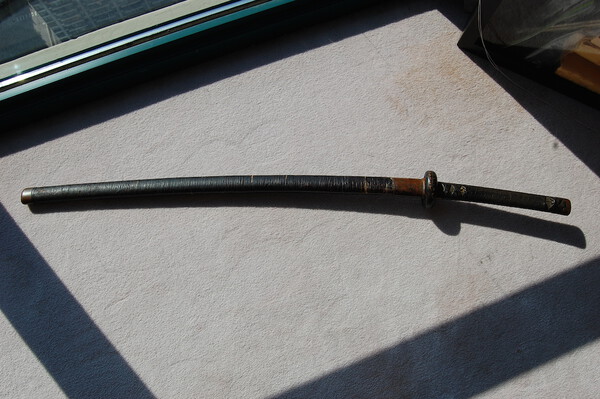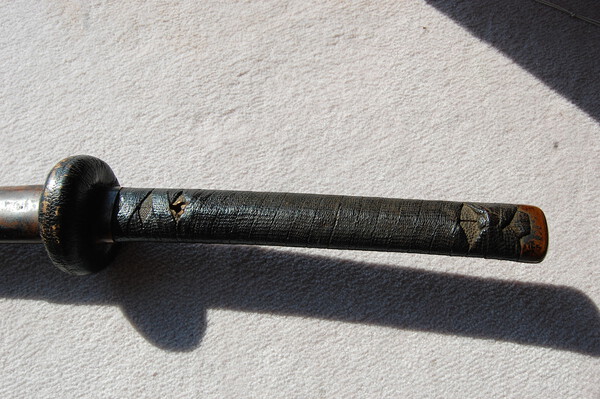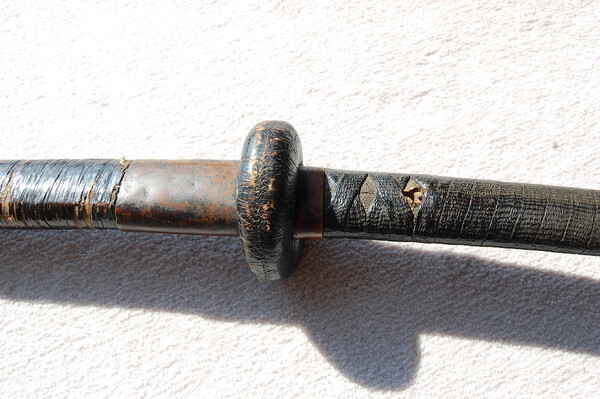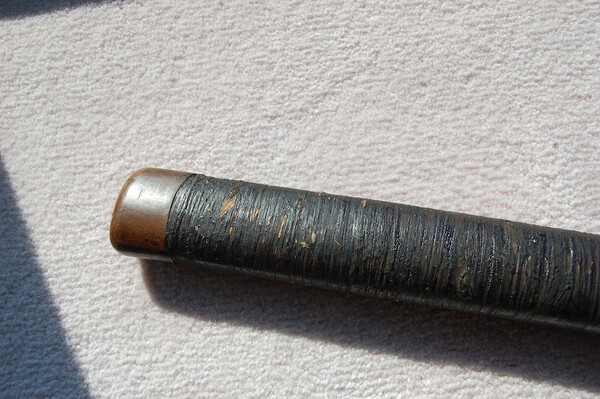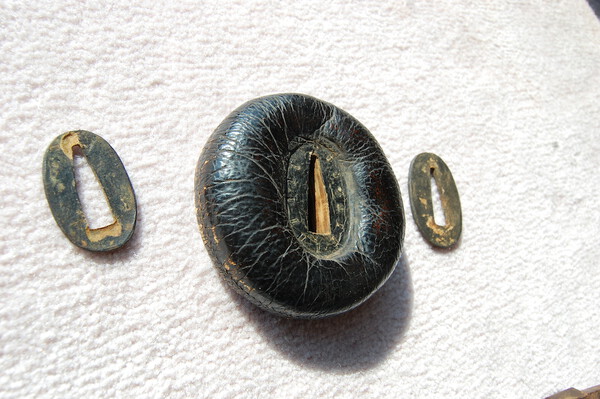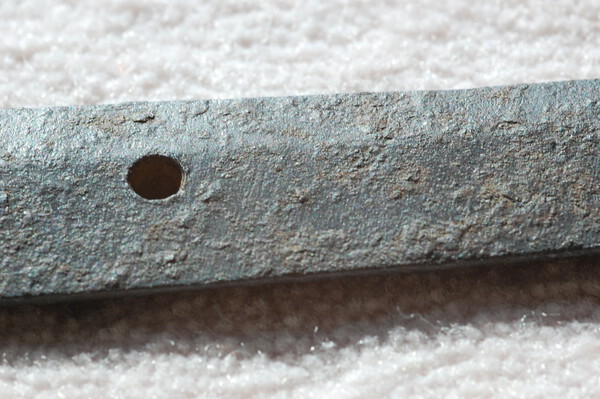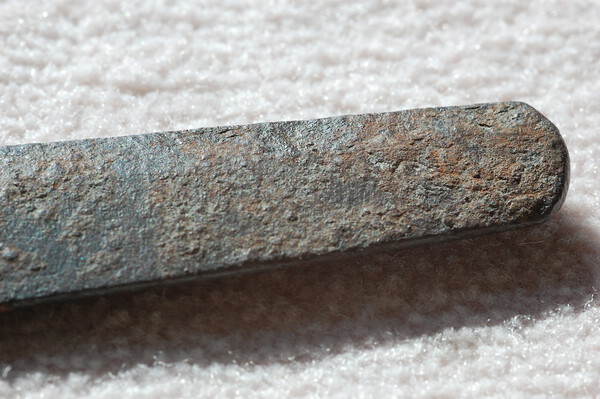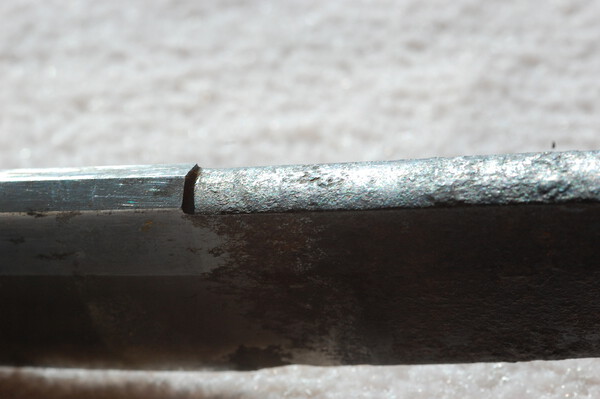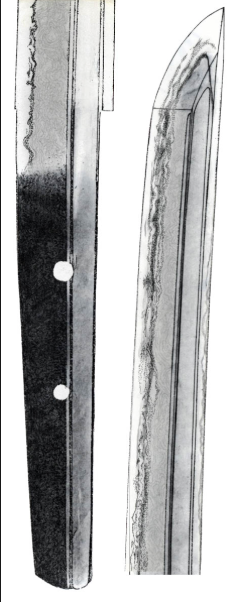-
Posts
2,959 -
Joined
-
Last visited
-
Days Won
18
Content Type
Profiles
Forums
Events
Store
Downloads
Gallery
Everything posted by Surfson
-
Hi All. As I mentioned, I have been out of town, and will be gone another week. I just caught up with this thread, and wow. There is a lot of content. Darcy and Chris, thanks for sharing a heap of knowledge on this sword and on muneyaki. Darcy, I'm impressed by the profile comparison of my sword and the other - pretty amazing. I will take to heart your recommendation to polish it. I still am mulling about getting NTHK papers first, but that's another issue. I will study your posts again on my return when I have the sword in hand. I will say that not only does it taper a great deal in the width, but also in the thickness. The nakago is quite thick, and the blade gets thin pretty quickly above the munemachi. By the time it gets to the monouchi, it is quite thin. In terms of the width, it is about two thirds in the yokote what it is in the machi. I didn't measure the ratio for the thickness, but I think that it tapers at least this much. All of this from memory, but I can take measurements on my return. Cheers, Bob
-
Hi Malcolm. The same has a join on the omote. I suppose that I am a senior member (at least chronologically, not based on expertise), and I have never seen koshirae like this! I hope that somebody recognizes it. Cheers, Bob
-
There is lots of content in your post Darcy, and I'm glad that you spoke up. I am certainly guilty of accumulating a lot of blades, but I will defend what I've done economically, as I have been cost sensitive and have bought more swords at a fraction of their market value than ones that were overpriced. Having said that, I am trying to better define my collecting, going after bigger game and planning to condense my collection to a smaller number of high quality blades. As to this sword, if I do submit it to NTHK and it comes up with a mundane Muromachi date and school, I would probably sell it rather than try to overturn the call by sending it to Japan. i have more swords worthy of polishing and restoration than I have funds to restore them with, so the decision is an important one to me. I appreciate your comment and information about nakago condition, and agree that this sword has some active rust. Other than applying some oil (is choji oil ok?), do you recommend anything else? I have taken horn to a nakago or two, but this one has such a variable surface that getting the horn into the crevices will be very tough. As to the kaeri, it's hard to tell whether it is muneyaki or a true kaeri. It is quite similar on both sides. Seeing the boshi is a challenge, and I don't think that I can take some good photos, but I'll try when I return from a trip in a couple of weeks. Finally, I am not sure what the bottom line is on your view of it. Do you think it is muromachi or late nambokucho or do you think that it has a chance to be much earlier, before nambokucho? Cheers, Bob
-
I would be happy to have any NMB members inspect it in hand at the upcoming Chicago show, assuming that I am able to attend (always depends on my travel schedule). Cheers, Bob
-
Malcolm, I believe these to be the original koshirae for this blade, and the blade is dated 1856. Based on the near total lack of wear on the tsuka, I find it hard to believe that it was used for some sort of training. In addition, the padded tsuba would be worn as well I would think if the blade was repeatedly struck by an opponents practice sword. If it is a practice sword, I don't think that it was used much. Have you ever seen this type of koshirae in the past? Cheers, Bob
-
Yes Franco, my likes and dislikes are very subjective, and many have been learned from other collectors and colleagues. I do want to avoid a big financial mistake, that is for sure. To me, investing $5K into this blade and having it stall out at Hozon would be a financial mistake. At the end of the day, my expertise will never match that of the true experts that are at the NBTHK and NTHK organizations (and some on this board!), and we are all aware that the views of these organizations about swords can really drive both the market value of an individual sword as well as the perceived worth subjectively. I am benefitting from this discussion, and do plan to come back to it once I have put the sword through a local shinsa. Cheers, Bob
-
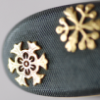
Good looking blade on ebay.
Surfson replied to bigjohnshea's topic in Auctions and Online Sales or Sellers
Wow John, you did him a big favor. I have to admit that if I had seen a $1500 BIN I would have bought it, and possibly flipped it. You are a true gentleman! -
Mariusz and Franco, you have both been quite helpful, thank you. Franco, I'm not sure what kind of collector I am. I love minty Mishina blades with lots of art in them, but I also love koto - the older and more interesting to view the better. I find that the latter, especially when mumei, challenge my ability to appraise much more. If I assume that this blade will paper, as we are collectively beginning to suspect, let's say early Muromachi or late Nambokucho, then I agree that it is worthy of restoration. Both of you raised the financial issue. I am in the enviable position that I have three or four swords that are all worthy (including possibly the Naoyoshi that is under discussion in another thread right now), so I will need to decide which are most worthy, based on both my responses and affections for them as well as the economic issues. If this one were to paper to an important school or to an earlier era, that would influence the economics of the decision. Strange mix of emotions and practicality, no?
-
I am enjoying this discussion, because it is going into an area in which I am naive. Malcolm, here are a few that I already took. Let me know additional features that would be informative. It's interesting to me that it doesn't have a kurikata, indicating that it was probably not carried or worn. Also, the saya wrap, which looks like baileen to me, appears to have been coated near the kojiri, perhaps to stem some wear. Cheers, Bob
-
Wow, lots of great feedback. As of now, I have been leaning toward getting a local shinsa, either NTHK-NPO or NTHK, before deciding about sending it to Japan. But I sense from some of you that if it were to paper to a secondary school and early Muromachi, some of you may have it restored anyway and others would reconsider. Do I have that right? I would love to hear what other collectors think about restoring Muromachi blades that aren't bundle swords but are actually well made. By the way, the macrophotography overemphasizes the hada grain size. The hada is barely visible with the naked eye. Cheers, Bob
-
Iga no Kami Fujiwara Kinmichi
-
I have been meaning to close the loop on this thread. This sword papered at the NTHK-NPO shinsa held in Florida earlier this year. Cheers, Bob
-
Thanks Chris. Well, I think that shinsa may be in order before sending this one to Japan. It is very rare to find ubu koto so long, whether it's muromachi or earlier. Cheers, Bob
-

Good looking blade on ebay.
Surfson replied to bigjohnshea's topic in Auctions and Online Sales or Sellers
Ha! I think that you are missing a......punk. As to the date, as an alternative it may be Tai-ei 13, or 1534, which goes along with the time of Kunitsugu. b -
Well this is fun Chris. I did fully disclose my weak photography skills. Do any of these photos lead you to reconsider? Cheers, Bob
-

Good looking blade on ebay.
Surfson replied to bigjohnshea's topic in Auctions and Online Sales or Sellers
I would like to find signed, polished TBH swords at $5-6K. Were they wakizashi? As to this one, the game is to guess where it ends up. I think that the restoration costs are more like $5-6K for it, including shirasaya, papers, shipping etc. The FK look nice, as does the tsuba and habaki. Yes, it needs a touch of machi-okuri, but not the end of the world. Unless the ebay world is reading this thread, there is no way this goes under $2400, and I think it will be much more. There are so many buyers in europe and asia these days. I would say that one third of my ebay sales go outside the US, although I am not a super frequent seller. -
I agree with Chris and would add that the yasurimei on the nakago looks like typical late Seki work to me.
-
Yes, that was my understanding. Since I was using google image, I thought that just using kaeri would capture all images of the various lengths of kaeri. The image that I posted looks very much like the kaeri (fukai) on this blade, so it got my interest up, but unfortunately, the link was not a good one, as is often the case with google image, since it searches the entire text of the site, not just the legend to individual photos. Anyway, I'm beginning to think that I might submit it to the NTHK-NPO and see what they say about it. I have to admit that the length and the shape both lead me to older than muromachi. What is it about the tang that makes you think muromachi, Chris? Cheers, Bob
-
All good points Chris. I will see if I can find an ultrasonic hardness tester. I just have to make sure that I don't use it to test my will.... Cheers, Bob
-
That's a useful guide Chris. I've been looking through Nagayama, and find at least three boshi shapes that it might fit; Jizo, notare komi and kaeri (either yoru, katai or fukai). Of those, the kaeri fukai looks most like it to me. When I google "kaeri boshi kamakura", I come up with this image, which looks quite like it. Oddly, it links to Yamashiro Rai Kunitsugu school, and when I go to the link, it is Bob Cole's nice site of schools but the image is not there. If I google kaeri fukai and Rai, I do get other examples of this type of boshi, but they are on tanto. Cheers, Bob
-

Good looking blade on ebay.
Surfson replied to bigjohnshea's topic in Auctions and Online Sales or Sellers
I'll play Brian, though I haven't studied the mei, and have no idea if it is good. I only found one in Hawley's and he's 25 points, so he may have been copied. Assuming it's a decent likeness of his signature, I'll predict $3250. Cheers, Bob -
One thing that has me wondering is that it has a small bit of muneyaki in the region of the kissaki. It's no more than an inch and goes back just past the yokote, but it looks to me like it should be a kantei point. Did koto blades have that type of turn back or is this a feature only of younger blades? I'm attaching a photo, though it's not great. Cheers, Bob
-
Jean, this sounds like it will work. Is there a certain type of file that I would need to get, other than avoiding a diamond file? Brian Tschernaga once showed me something similar. With a sharpened blade, if he wants to test whether the edge is still tempered or not (e.g. to test whether the hamon runs off an old blade at the boshi when it may have been dressed up by a polisher), he tried to slice some metal off of a penny. If it succeeded, then it is still hardened. If not, then it is non hardened metal. I hope that I'm recalling this correctly. Your test is akin to this except the blade is the test piece, not the penny (or in this case the file). I did find that there are two different hardness testers available. One uses ultrasound and the other uses some sort of compression device. They are about $4 and $8K respectively, and I have no idea what industry uses them or how I can track one down.
-
Interesting post Malcolm, and I had to google all of the terms that you introduced. It's hard for me to imagine this sword used in the gekken, since it is fairly heavy and quite long (over 34 inches). As to the history of marshall arts, I never heard about the lineages or the connection to Hokkaido. Cheers, Bob
-
It's a good suggestion, Lance. The shinogi seems to be fairly high, which I understand is a feature of Yamato blades. I couldn't take good pictures of the hamon, but there appears to be a mix of masame and mokume. Cheers, bob


